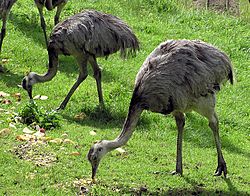Rheas facts for kids
Quick facts for kids Rhea |
|
|---|---|
 |
|
| American rhea, Rhea americana | |
| Scientific classification | |
| Kingdom: | |
| Phylum: | |
| Class: | |
| Order: |
Rheiformes
|
| Family: |
Rheidae
|
| Genus: |
Rhea
|
| Species | |
|
|
The rheas are large, flightless birds that live in South America. They are part of a group of birds called ratites. This means they are big birds that cannot fly. Unlike flying birds, they do not have a special bone in their chest (called a keel) where strong flight muscles would attach.
What are Rheas?
The greater or American rhea is also known as the 'Nandu'. It is a very large bird found in the forests of South America. This ratite is the biggest bird in all of the Americas. Rheas are very fast runners. When they run, their long necks stretch out almost flat to the ground. Rheas often gather in groups of 20 to 30 birds. The smaller Darwin's rhea, Rhea pennata, mostly lives in the southern parts of South America.
What Rheas Eat
Rheas mostly eat plants, fruits, seeds, and nuts. But they also like to eat insects and other small animals. Sometimes, they will even eat small lizards.
Life Cycle
Female rheas lay a clutch of 12 to 30 yellow-cream eggs. The male rhea does most of the work for the family. He digs the nest, which is just a simple scrape in the ground. He then sits on the eggs to keep them warm for about six weeks. After the chicks hatch, the male rhea raises them. Rheas become fully grown and can have their own babies when they are about two years old.
How Rheas Evolved
For a long time, scientists thought that all ratites (like rheas, ostriches, and emus) came from one single group. They believed these birds evolved together on a supercontinent called Gondwana. This was thought to have happened a very long time ago, during the Upper Cretaceous period. As Gondwana slowly broke apart, the different parts drifted away. These parts became the continents we know today, like Africa and the Indian subcontinent. Scientists thought the ratites then evolved separately on these new lands.
However, newer studies using DNA have changed this idea. By looking at the DNA of these birds, scientists found that ratites actually split off from each other more recently. This means they probably did not all share a common ancestor on Gondwana. Even so, these DNA studies still show that rheas and the ratites living in Australasia and Oceania are closely related. They do share a common ancestor that is unique to their group.
Images for kids
-
Greater rheas (Rhea americana) dustbathing. The two individuals on the left are leucistic.
See also
 In Spanish: Ñandú para niños
In Spanish: Ñandú para niños







